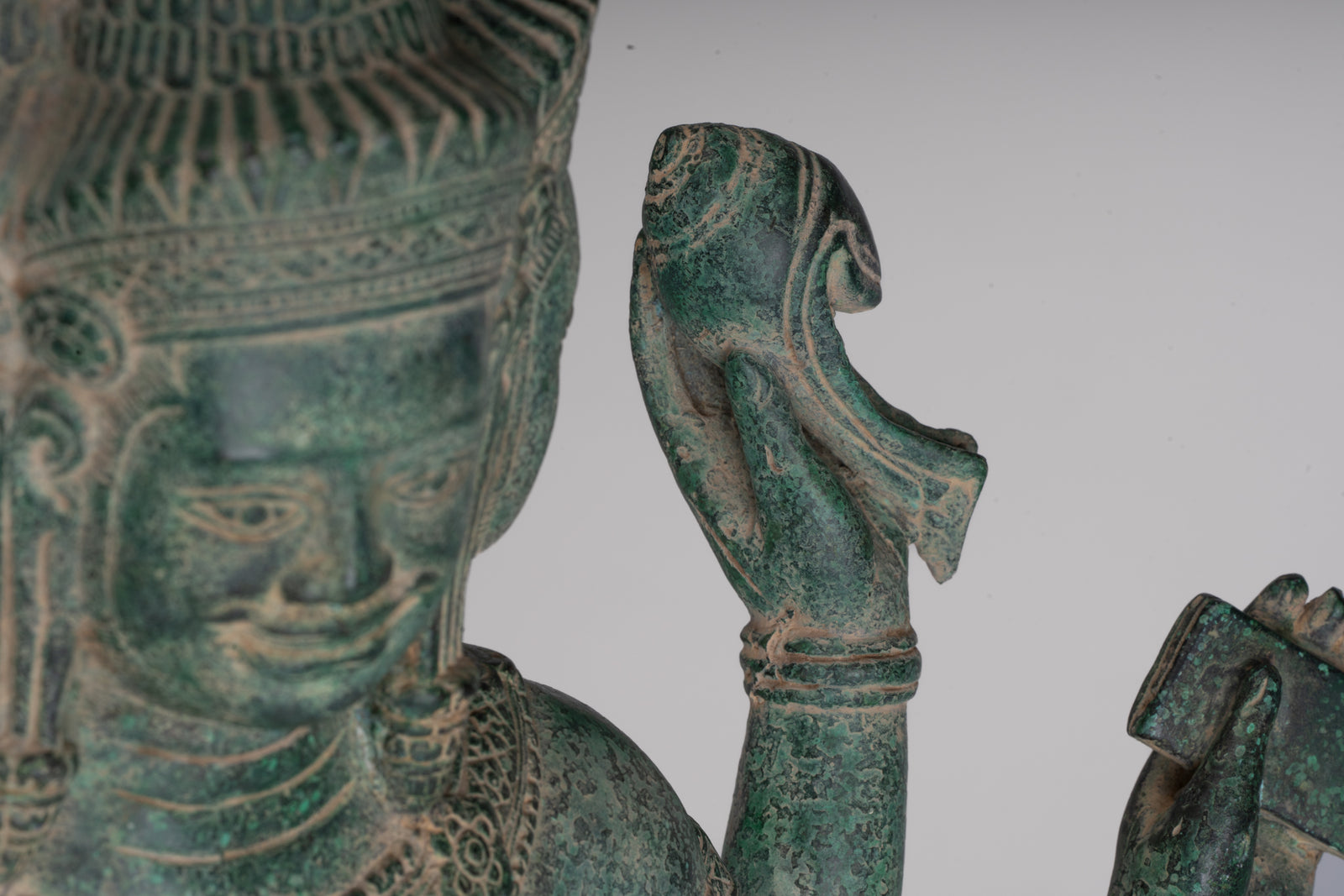
The Rise of Brahma in Cambodia: Hindu Influence and Its Integration into Cambodian Culture
Brahma, the Hindu god of creation, holds an intriguing place in the religious and cultural landscape of Cambodia.
Although Cambodia is predominantly Buddhist today, Hinduism played a vital role in shaping its early history, particularly through the Khmer Empire (9th-15th centuries), during which the Hindu pantheon, including Brahma, was widely worshipped.
The integration of Brahma into Cambodian beliefs illustrates the complex, syncretic nature of Southeast Asian spirituality, where Hindu and Buddhist practices coexisted, influenced one another, and merged over time.
In this blog post, we will explore the historical and cultural rise of Brahma in Cambodia, tracing his role from the height of the Khmer Empire to his continued influence in Cambodian spiritual practices and artistic traditions.
Brahma in Hinduism: The God of Creation
Brahma, one of the primary deities in Hinduism, is often depicted as a four-headed god who represents the creator of the universe. He is part of the Trimurti, which includes Vishnu, the preserver, and Shiva, the destroyer. While Brahma’s role in Hinduism is significant, he is not as widely worshiped as other deities like Vishnu or Shiva. Instead, Brahma is traditionally viewed as the creator god, responsible for the creation of the universe and all living beings, as well as the embodiment of wisdom and knowledge.
In Hindu mythology, Brahma is often described as dwelling in the Brahmaloka, a celestial realm above the earthly realm, symbolizing the creative force behind existence.
Hindu Influence in Cambodia: The Khmer Empire and Beyond
The spread of Hinduism into Cambodia can be traced back to the 1st century CE, when Indian traders, scholars, and priests began to establish cultural and religious connections with Southeast Asia. The Khmer Empire, which flourished between the 9th and 15th centuries, became the primary center of Hindu and Buddhist influence in the region. During this time, the Cambodian kingdom adopted many elements of Indian culture, including language, art, and religion.
The Role of Brahma in the Khmer Empire
The Khmer Empire was a melting pot of Hindu and Buddhist ideas, and Brahma was one of the key figures in the Hindu pantheon venerated by the Cambodian royalty. Many of the great kings of the empire, such as Jayavarman II and Jayavarman VII, were instrumental in blending Hindu and Buddhist practices into their royal rule, often seeking divine favor from gods like Brahma.
-
Angkor Wat: Perhaps the most famous example of Brahma’s influence is found in the monumental Angkor Wat temple, originally dedicated to Vishnu, but which also includes references to Brahma and other deities from the Hindu pantheon. The temple complex, which is one of the largest religious monuments in the world, features intricate carvings and reliefs of Hindu gods and goddesses, including Brahma. The temple’s architecture and layout reflect the Hindu cosmology, with a central temple representing Mount Meru, the axis of the universe, surrounded by celestial realms where Brahma and other gods reside.
-
Royal Patronage: The kings of the Khmer Empire frequently commissioned the construction of temples dedicated to Hindu gods, and Brahma was often represented alongside Vishnu and Shiva. These temples were seen not only as places of worship but also as symbols of the divine legitimacy of the monarchy. By worshipping Brahma, kings sought to reinforce their role as the divinely appointed rulers of the land.
Phnom Kulen and the Presence of Brahma in Cambodia
While Angkor Wat stands as the most prominent symbol of Hindu influence in Cambodia, Phnom Kulen (a mountain and historical site in Cambodia) is another example where Brahma's significance is evident. Phnom Kulen is historically important as it was the site of the founding of the Khmer Empire and is home to several Hindu shrines.
The river of a thousand lingas, known for its ancient carvings of lingams (symbolic representations of Shiva), also includes representations of Brahma and other deities. These carvings highlight the continued reverence for Brahma and other Hindu gods in the region long after the decline of the Khmer Empire.
The Transition to Buddhism: Brahma's Continued Role
The transition from Hinduism to Buddhism in Cambodia occurred gradually, particularly with the advent of Theravada Buddhism from Sri Lanka around the 13th century. As Buddhism became the dominant religion in Cambodia, Hindu deities, including Brahma, were absorbed into the new religious framework. Brahma’s role shifted from a central god of worship to a more symbolic and mythological figure.
Brahma in Buddhist Context
In Buddhist cosmology, Brahma is considered one of the devas (gods) who reside in the higher realms of existence, particularly the Brahmaloka. Although Buddhism does not focus on gods in the same way as Hinduism, Brahma’s continued presence in Cambodian Buddhism reflects a deep cultural and spiritual connection with his Hindu roots.
In some Buddhist interpretations, Brahma is seen as a benevolent and protective deity who helps guide individuals on their spiritual journey. Brahma is also believed to have played a role in the life of the Buddha. According to Buddhist texts, Brahma was one of the deities who visited the Buddha when he attained enlightenment, encouraging him to teach others.
Brahma in Cambodian Art and Architecture
Despite the rise of Buddhism in Cambodia, Brahma’s legacy can still be seen in Cambodian art and architecture, particularly in the remnants of Hindu-inspired monuments.
1. Temple Architecture
The temples of Angkor, including Angkor Wat, Angkor Thom, and Banteay Srei, are filled with depictions of Hindu gods, including Brahma. Sculptures, bas-reliefs, and murals show Brahma with his four heads, representing the aspects of creation and divine wisdom. These artistic representations of Brahma in Cambodian temples continue to draw attention from tourists and scholars alike, highlighting the enduring influence of Hinduism in Cambodia’s spiritual and cultural heritage.
2. Cambodian Sculpture and Iconography
Cambodian sculptors, both during the Khmer Empire and in later periods, often created statues and reliefs depicting Brahma in traditional Hindu styles. These statues are often part of larger temple complexes and serve as reminders of the country’s Hindu past. Though Buddhism is the dominant religion today, the artistry and iconography that emerged from the Hindu tradition continue to be celebrated and studied.
Brahma in Contemporary Cambodia
While Brahma is no longer a central figure in Cambodian religious practice, his presence remains significant in certain cultural and ceremonial contexts. Some local shrines and temples still honor Brahma, particularly in places with strong historical ties to Hinduism. Brahma is also a figure revered in Cambodian New Year celebrations, where elements of both Hinduism and Buddhism are interwoven in rituals and prayers for prosperity, health, and protection.
1. Brahma’s Role in Cambodian Festivals
During the Cambodian New Year, elements of Hindu traditions are often observed alongside Buddhist rituals. Devotees may pray to Brahma as part of the larger suite of divine beings they honor for blessings of good fortune, abundance, and protection. Brahma’s association with creation and protection ties into the hopes for a fruitful and harmonious year ahead.
2. Cultural Legacy and National Identity
Brahma, along with other Hindu deities, forms an integral part of Cambodia's cultural identity. The artistic legacy of Hinduism and the historical significance of Hindu deities like Brahma continue to inform the nation’s artistic expressions, from sculptures and architecture to dance and literature.
Conclusion: Brahma’s Enduring Influence in Cambodia
The rise of Brahma in Cambodia is a fascinating example of the intermingling of Hindu and Buddhist traditions that has shaped the country’s cultural and religious identity over millennia. From the grandeur of Angkor Wat to the temple carvings in Phnom Kulen, Brahma’s legacy as the god of creation and protector of the universe continues to resonate in the rich tapestry of Cambodian spiritual and cultural life.
Though Cambodia is predominantly Buddhist today, the reverence for Brahma is a testament to the enduring influence of Hinduism in Southeast Asia and the dynamic, ever-evolving nature of Cambodian religious traditions. His presence in art, architecture, and cultural practices reflects the deep connections between the past and present, bridging Hinduism, Buddhism, and the rich cultural heritage of Cambodia.


